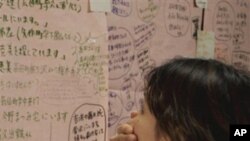Japanese officials have suspended operations aimed at preventing a stricken nuclear plant from melting down, after a surge in radiation made it too dangerous for workers to remain there.
The chief government spokesman, Yukio Edano, told reporters that radiation levels at the quake-stricken Fukushima plant spiked at mid-morning. He said the remaining workers at the plant were evacuated to a safe area, because of the risk posed by the increased radiation.
Edano said levels have now receded somewhat, and that officials are monitoring them to determine when it would be safe to send the workers back into the plant.
|
Listen to Les Carpenter speak with VOA's Steve Herman, who is reporting from Koriyama in the disaster region in northern Japan. |
Early Wednesday, what appeared to be white smoke was rising from one of the reactors at the plant, which was crippled by last week's devastating earthquake and resulting tsunami. Edano said officials were trying to determine the cause of the smoke, but that the most likely cause is steam escaping from a ruptured containment vessel in one of the reactors.
Japan's government is trying to avert a major nuclear disaster from the crippled plant. Tens of thousands of people have been evacuated from a 20-kilometer area around the facility.
Watch an explanation of the crisis at the Fukushima nuclear plant (via NHK)
Authorities also are rushing doctors and emergency supplies to thousands of people who have been left without food, water and shelter following the 9.0 magnitude earthquake and subsequent tsunami. Japan's NHK television on Tuesday quoted government officials as saying that 3,000 are confirmed dead, but more than 10,000 are missing and feared dead.
The scale of the triple disaster is enormous. U.N. Office for the Coordination of Humanitarian Affairs spokesperson Stephanie Bunker told VOA Tuesday she has not seen a disaster quite like this before.
Images from Japan
Television pictures from hard-hit Sendai show people lined up for water and canned food, and some stores rationing food sales to 10 items per person. In other areas, the 100,000 personnel deployed by the government are attempting to rescue survivors stranded by the flood waters and mountains of debris.
Rescue crews still are struggling through debris-blocked roads to get to hundreds of thousands of people whose towns and villages were leveled by Friday's earthquake and tsunami.
The government says 15,000 people have been rescued and 450,000 have been evacuated nationwide.













